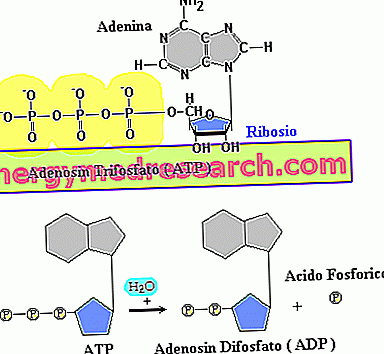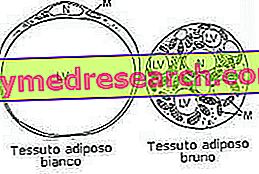Molecule present in all living organisms, for which it represents the main form of energy storage immediately available.
FEATURES
Adenosine triphosphate, or ATP, consists of a molecule of adenine and one of ribose (sugar with 5 carbon atoms) to which three phosphoric groups are bound, by means of two high-energy bonds. The energy stored in the ATP derives from the degradation of compounds called carbohydrates, proteins and lipids, through metabolic reactions that take place in the absence or in the presence of energy. Since the energetic function of ATP is intimately connected to the catalytic function of enzymes, ATP is considered a coenzyme.

ATP structure and ATP conversion to ADP
HYDROLYSIS AND PHOSPHORYLATION OF ATP
The high energy ATP bonds are those that bind the three phosphate groups together. These bonds can be split by means of a hydrolysis reaction; after breaking, they release a large amount of energy, equal to about 34 kJ per mole (about 7.5 Kcal). ATP hydrolysis occurs by the enzyme called ATPase. In addition to energy release, partial hydrolysis of ATP leads to the formation of a molecule of adenosine diphosphate (ADP) and a phosphate group; total hydrolysis forms a molecule of adenosine monophosphate and two phosphate groups. Once split, the ATP is synthesized again by phosphorylation reactions of the ADP, through which the phosphate groups are added to the molecules.
IMPORTANCE OF ATP
Almost all cellular reactions and processes of the body that require energy are fed by the conversion of ATP into ADP; among them there are, for example, the transmission of nerve impulses, muscle contraction, active transport through plasma membranes, protein synthesis and cell division. In vertebrates the phosphate group necessary for this reaction is stored in a compound, called creatine phosphate, which is found mainly in muscle tissue.
CELL BREATHING
Process that takes place in cells in the presence of oxygen (aerobiosis), through which the nutrients deriving from digestion (in animals) or photosynthesis are oxidized in order to produce the energy necessary for metabolism. In particular, the main molecule that acts as a substrate for cellular respiration is glucose; the energy obtained is stored in the high-energy bonds contained in the adenosine triphosphate molecule, ATP.
Cellular respiration leads to the net formation of 38 ATP molecules for each glucose molecule involved in the reaction. Glycolysis can be the first cycle of cellular respiration reactions in the presence of oxygen.



